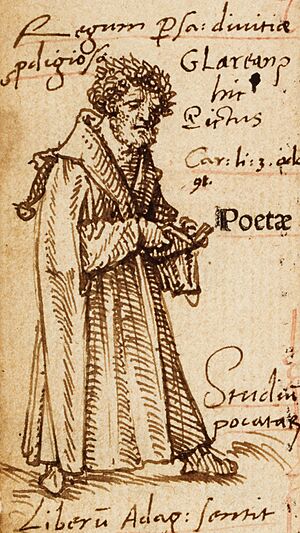Heinrich Glarean facts for kids

Heinrich Glarean, also known as Henricus Glareanus, was a smart Swiss person who lived a long time ago (from 1488 to 1563). He was a music theorist, which means he studied and wrote about how music works. He was also a poet and a humanist, someone who loved learning about people and ancient cultures. He was born in a place called Mollis in Switzerland and later passed away in Freiburg im Breisgau, Germany.
About Heinrich Glarean
Heinrich Glarean was born Heinrich Loriti in Mollis, a town in Canton Glarus, Switzerland. His father was a politician, a person who helps run the government. Even as a boy, Heinrich was very clever. He helped take care of cattle but also received a good education.
He studied at the University of Cologne, learning about religion, philosophy, math, and music. In Cologne, he wrote a poem to honor Emperor Maximilian I. From 1514, he taught Greek and Latin in Basel. There, he met Erasmus, a famous scholar, and they became lifelong friends.
In 1515, Glarean worked as a lecturer at the University of Pavia for a few months. However, he returned to Basel because of the Battle of Marignano, a big fight between Switzerland and France.
His Important Music Books
Glarean's first book about music was called Isagoge in musicen. It was printed in 1515. In this book, he talked about the basic parts of music. He probably used it to teach his students.
But his most famous book was the Dodecachordon. He published it in Basel in 1547. This was a huge and very important book about music theory during the Renaissance period. The Dodecachordon also included writings on philosophy and biographies of musicians. It even had 120 complete songs by famous composers of that time. These composers included Josquin, Ockeghem, Obrecht, and Isaac.
The book had three main parts. It started by looking at the work of Boethius, who wrote a lot about music in the 500s. Then, it explored how musical modes were used in plainsong (like Gregorian chant) and monophony (music with one melody). Finally, it ended with a detailed study of how modes were used in polyphony (music with many melodies at once).
The Twelve Modes
The most important idea in the Dodecachordon was Glarean's suggestion that there are actually twelve musical modes, not just eight. Before him, most people, like the music theorist Pietro Aron, thought there were only eight.
The four new modes he added were the Aeolian (modes 9 and 10) and Ionian (modes 11 and 12). These modes are like the minor and major scales we use today. Glarean even said that the Ionian mode was the one composers used most often in his time.
His work had a huge impact. Many music theorists who came after him, such as Zarlino, accepted his idea of twelve modes. Even though we don't focus on the difference between "plagal" and "authentic" forms of modes anymore (which reduces the number from twelve to six), Glarean's explanation of musical modes is still important today.

